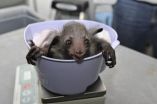(Press-News.org) VIDEO:
Duke Lemur Center had made 48 years of primate data available online.
Click here for more information.
DURHAM, N.C. -- A 48-year archive of life history data for the world's largest and most diverse collection of endangered primates is now digital and available online. The Duke Lemur Center database allows visitors to view and download data for more than 3600 animals representing 27 species of lemurs, lorises and galagos -- distant primate cousins who predate monkeys and apes -- with more data to be uploaded in the future.
Staff at the center observe and record virtually every aspect of an animal's life from cradle to grave. For each animal they know when it was born, who its parents were, how fast it grew, what it ate, which animals it mated with, how many offspring it had, and when and why it died.
Hiddleston is one of them. Hiddleston is a blue-eyed black lemur, which makes him one of the 25 most endangered primates in the world. Since he was born in March 2013, staff at the Duke Lemur Center have catalogued minute details of his life in their daily logbooks. They know how big he was at birth and when he tried his first solid foods. They monitor his weight and note how he interacts. They even tracked his first attempts to climb a tree.
Hiddleston isn't alone. When primatologist Sarah Zehr first arrived at the Duke Lemur Center in 2007, she found a treasure trove of data about the lives, health and habits and of more than 4000 animals, dating from the center's beginnings in 1966.
The fact that lemurs are at risk of dying out makes it unlikely that a collection of similar size will ever be recreated, Zehr said. "Many of these species are critically endangered in the wild, so they're unlikely to be held in captivity again. This means that the data are irreproducible."
Getting at this one-of-a-kind data, however, was a difficult task. Much of the data were locked up in handwritten notebooks or typed paper records. "The downside of the paper records is they're vulnerable, they're not digitized, and we only have a single copy -- so they're impossible to analyze," Zehr said.
The center migrated to electronic records in the 1990s, but that still left much of the data buried in odd computer files or hard-to-use databases.
That began to change in 2012, when Zehr and software developers Freda Cameron and the late Richard Roach, formerly of SAS, started working on a project to assemble the information from the various source files and convert it into a single, easily searchable format.
It took them three years to compile and digitize the data and put it online. Visitors to the new database will find birth and death dates for each animal, IDs and ages for its parents, any litter mates or siblings, lifelong weight records, breeding season, gestation length and number of offspring -- much of which would be difficult if not impossible to collect at a similar level of detail for lemurs living in the wild.
Users can also find out whether any biological samples are available for an animal. The bank of biological samples at the Duke Lemur Center contains nearly 10,000 samples for more than 1000 individuals. It's a modern ark of things like blood, serum, DNA, urine, and small pieces of skin, organs and other tissues -- many taken during routine veterinary procedures for diagnostic tests or when an animal dies of natural causes -- all preserved in freezers for the future.
Thanks to the center's captive breeding program the data continue to come in. In the next year they plan to add additional records, such as health and reproductive status, causes of death, behavior, and group size and composition for each animal over time.
The hope is that the data will help institutions better care for lemurs in captivity, and help scientists understand these animals in order to better protect them in the wild.
The database will also allow generations of future researchers to tackle a wide range of questions. Researchers studying aging and longevity, for example, will be able to compare maximum lifespans in captivity for different primate species, and pinpoint cellular and molecular traits that distinguish long-lived primates from short-lived ones.
INFORMATION:
The project was supported by the National Evolutionary Synthesis Center and the National Science Foundation (DBI 1258440). Additional support was provided by the Duke Lemur Center and Duke's Natural Sciences Division.
The data are available online in the Dryad Digital Repository at http://dx.doi/10.5061/dryad.fj974 and via the Duke Lemur Center website at http://lemur.duke.edu/duke-lemur-center-database/.
CITATION: Zehr, S., et al. (2014). "Life history profiles for 27 strepsirrhine primate taxa generated using captive data from the Duke Lemur Center." Scientific Data. http://www.nature.com/articles/sdata201419#sthash.kbrmFH8e.dpuf
Nearly 50 years of lemur data now available online
2014-07-24
ELSE PRESS RELEASES FROM THIS DATE:
New mass map of a distant galaxy cluster is the most precise yet
2014-07-24
Astronomers using the NASA/ESA Hubble Space Telescope have mapped the mass within a galaxy cluster more precisely than ever before. Created using observations from Hubble's Frontier Fields observing programme, the map shows the amount and distribution of mass within MCS J0416.1-2403, a massive galaxy cluster found to be 160 trillion times the mass of the Sun. The detail in this mass map was made possible thanks to the unprecedented depth of data provided by new Hubble observations, and the cosmic phenomenon known as strong gravitational lensing.
Measuring the amount and ...
University of Delaware researcher describes new approach for creating organic zeolites
2014-07-24
Yushan Yan, Distinguished Professor of Engineering at the University of Delaware, is known worldwide for using nanomaterials to solve problems in energy engineering, environmental sustainability and electronics.
His early academic work focused on zeolites, porous rock with a well-defined, crystalline structure. At the atomic scale, their pore size is so precisely decided that zeolites can separate molecules with size differences of merely a fraction of an angstrom (one-tenth of a nanometer), making them useful to the chemical and petroleum industries as molecular sieves ...
Background TV can be bad for kids
2014-07-24
Parents, turn off the television when your children are with you. And when you do let them watch, make sure the programs stimulate their interest in learning.
That's the advice arising from University of Iowa researchers who examined the impact of television and parenting on children's social and emotional development. The researchers found that background television—when the TV is on in a room where a child is doing something other than watching—can divert a child's attention from play and learning. It also found that non-educational programs can negatively affect children's ...
Wireless home automation systems reveal more than you would think about user behavior
2014-07-24
This news release is available in German.
Home automation systems that control domestic lighting, heating, window blinds or door locks offer opportunities for third parties to intrude on the privacy of the inhabitants and gain considerable insight into their behavioral patterns. This is the conclusion reached by IT security expert Christoph Sorge and his research team at Saarland University. Even data transmitted from encrypted systems can provide information useful to potential burglars. Professor Sorge, who holds the juris Professorship in Legal Informatics ...
Natural products from plants protect skin during cancer radiotherapy
2014-07-24
Radiotherapy for cancer involves exposing the patient or their tumor more directly to ionizing radiation, such as gamma rays or X-rays. The radiation damages the cancer cells irreparably. Unfortunately, such radiation is also harmful to healthy tissue, particularly the skin over the site of the tumor, which is then at risk of hair loss, dermatological problems and even skin cancer. As such finding ways to protect the overlying skin are keenly sought.
Writing in the International Journal of Low Radiation, Faruck Lukmanul Hakkim of the University of Nizwa, Oman and Nagasaki ...
Identified a key molecule in flies that adjusts energy use under starvation conditions
2014-07-24
Most scientific literature devoted to the protein p53 refers to cancer biology, and the functions of this molecule as a tumour suppressor have been described in detail. Furthermore, also in cancer biology, it is known that p53 inhibits the metabolic pathways of tumour cells in order to block their metabolism and prevent their rapid growth and proliferation.
The most innovative research on p53 attempts to unveil its functions in the management of energy stores and nutrients in healthy cells. Recent studies with cell cultures have demonstrated that p53 is activated in response ...
Metastatic brain tumor treatment could be on the horizon with use of SapC-DOPS
2014-07-24
CINCINNATI -- Over half of patients being seen in the clinic for a diagnosed brain tumor have metastatic cancer, which has no treatment and detrimental outcomes in most cases.
However, a Cincinnati Cancer Center (CCC) study, published in the advance online edition of the journal Oncotarget, provides hope that previously studied SapC-DOPS could be used for treatment of brain cancer that has spread.
Xiaoyang Qi, PhD, member of the CCC, associate director and associate professor in the division of hematology oncology at the University of Cincinnati (UC) College of Medicine ...
Seeing the same GP at every visit will reduce emergency department attendance
2014-07-24
Attendances at emergency departments can be reduced by enabling patients to see the same GP every time they visit their doctor's surgery. This is just one of several recommendations made in a report published today, led by researchers at the University of Bristol.
Called 'Primary care factors and unscheduled secondary care: a series of systematic reviews', the report has been compiled by researchers from the University's Centre for Academic Primary Care who looked at evidence from studies around the world. They found that patients who saw the same GP every time they attended ...
New research: When it hurts to think we were made for each other
2014-07-24
Toronto - Aristotle said, "Love is composed of a single soul inhabiting two bodies." Poetic as it is, thinking that you and your partner were made in heaven for each other can hurt your relationship, says a new study.
Psychologists observe that people talk and think about love in apparently limitless ways but underlying such diversity are some common themes that frame how we think about relationships. For example, one popular frame considers love as perfect unity ("made for each other," "she's my other half"); in another frame, love is a journey ("look how far we've ...
Four billion-year-old chemistry in cells today
2014-07-24
Parts of the primordial soup in which life arose have been maintained in our cells today according to scientists at the University of East Anglia.
Research published today in the Journal of Biological Chemistry reveals how cells in plants, yeast and very likely also in animals still perform ancient reactions thought to have been responsible for the origin of life – some four billion years ago.
The primordial soup theory suggests that life began in a pond or ocean as a result of the combination of metals, gases from the atmosphere and some form of energy, such as a lightning ...








